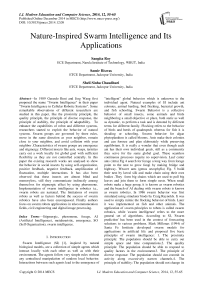Nature-Inspired Swarm Intelligence and Its Applications
Автор: Sangita Roy, Samir Biswas, Sheli Sinha Chaudhuri
Журнал: International Journal of Modern Education and Computer Science (IJMECS) @ijmecs
Статья в выпуске: 12 vol.6, 2014 года.
Бесплатный доступ
In 1989 Gerardo Beni and Jing Wang first proposed the name "Swarm Intelligence" in their paper "Swarm Intelligence in Cellular Robotic Systems". Some remarkable observations of different researchers are studied in this paper, like the proximity principle, the quality principle, the principle of diverse response, the principle of stability, the principle of adaptability. To enhance the capabilities of robot and different systems, researchers started to exploit the behavior of natural systems. Swarm groups are governed by three rules, move in the same direction as your neighbor, remain close to your neighbor, and avoid collision with your neighbor .Characteristics of swarm groups are emergence and stigmergy. Different insects like ants, wasps, termites carry out a work locally for global goal with sufficient flexibility as they are not controlled centrally. In this paper the existing research works are analysed to show the behavior in social insects by using self-organization, positive feedback, negative feedback, amplification of fluctuation, multiple interactions. It has also been observed that these insects are almost blind and memoryless, still they communicate indirectly among themselves for stigmergic effect by using pheromone. Implementation of swarm intelligence in robotics i.e., swarm robots are narrated. The limitations of swarm robots as well as factors behind the success of swarm robotics have also been encompassed. Finally authors focus on swarm robots applications in telecommunication fields, civil engineering and digital image processing.
Stigmergic, pheromone, forage, AI (Artificial Intelligence), metaheuristic, emergence, SO (Self Organization), swarm intelligence
Короткий адрес: https://sciup.org/15014715
IDR: 15014715
Текст научной статьи Nature-Inspired Swarm Intelligence and Its Applications
Published Online December 2014 in MECS DOI: 10.5815/ijmecs.2014.12.08
Swarm Intelligence (SI) [1], inspired by natural biological models, are a collection of simple agents which interact locally with each other as well as with their environment. The agents follow very simple rules without any centralized manipulation of random local behavior. Interactions between such agents lead to the emergence of
"intelligent" global behavior which is unknown to the individual agent. Natural examples of SI include ant colonies, animal herding, bird flocking, bacterial growth, and fish schooling. Swarm Behavior is a collective behavior of small insects, some animals and birds neighboring a small objective or place, both static as well as dynamic, to perform a task and is denoted by different terms for different family. Flocking refers to the behavior of birds and herds of quadrupeds whereas for fish it is shoaling or schooling. Swarm behavior for algae phytoplankton is called blooms. Ants make their colonies and can foresee and plan elaborately while preserving equilibrium. It is really a wonder that even though each ant has their own individual goals, still as a community they serve for the same global goal. These seamless continuous processes require no supervision. Leaf cutter ants (Atta) Fig 4 search for forage a long way from forage point to the nest to grow fungi by making bridge and highway. Weaver ants (genus oecophylla) Fig. 5 build their nest by larval silk and make chain using their own bodies .They form big chains which are used to pull big leaves and join them to form simple nests. When small robots make a huge group, it is known as swarm robotics and the branch of AI dealing with swarm robots is known as swarm robotics. In 1986 swarm behavior was first simulated using simulator biods by Craig Raynolds. It was used to simply mimic the flocking behavior of birds. Later it was implemented on fish and other animals. The application of swarm principles to robots is called swarm robotics, while 'swarm intelligence' refers to the more general set of algorithms. According to SI, 'Swarm prediction' has been used in the context of forecasting solutions to various problems. Mark Millonas (1994) of Santa Fe Institute developed swarm models for applications in artificial life and proposed five basic principles of swarm intelligence: 1. The proximity principle: The population should be able to carry out simple space and time computations.2. The quality principle: The population should be able to respond to quality factors in the environment.3. The principle of diverse response: The population should not commit its activity along excessively narrow channels.4. The principle of stability: The population should not change its
mode of behavior every time the environment changes.5. to change the behavior mode when it’s worth the The principle of adaptability: The population must be able computational price.
Table 1. Lists of Swarm Intelligence Inspired Algorithms
|
Sl. no. |
Algorithm |
Paper |
Date |
|
1. |
Artificial immune systems |
“The immune system, adaptation and machine learning” by Farmer, Packard, Perelson. |
1986 |
|
2. |
Stochastic diffusion search |
J.M. Bishop, Stochastic Searching Network. Proc. 1st IEE Conf. ANNs, London. |
1989 |
|
3. |
Ant Colony optimization |
M Dorigo in doctoral thesis “Ant System”. |
1992 |
|
4. |
Particle swarm optimization |
Particle swarm optimization by Dr. Eberhart and Dr. Kennedy |
1995 |
|
5. |
Self-propelled particles |
Vicsek, T.; Czirok, A.; Ben-Jacob, E.; Cohen, I. & Shochet, O. "Novel type of phase transition in a system of self-driven particles" |
1995 |
|
6. |
Fish Algorithm |
X.-L. Li, Z.-J. Shao and J.-X. Qian. Optimizing method based on autonomous animats: Fish-swarm algorithm. Xitong Gongcheng Lilun yu Shijian/System Engineering Theory and Practice, 22(11):32, |
2002 |
|
7. |
Artificial bee colony algorithm |
Dervis Karaboga, An Idea Based On Honey Bee Swarm for Numerical Optimization, Technical Report-TR06,Erciyes University, Engineering Faculty, Computer Engineering Department. |
2005 |
|
8. |
Virtual bees |
X.-S. Yang. Engineering optimizations via nature-inspired virtual bee algorithms. volume 3562, pages 317–323 |
2005 |
|
9. |
Intelligent water drops |
Problem Solving by Intelligent Water Drops by Hamed Shah _ Hosseini IN . |
2007 |
|
10. |
Multi-swarm optimization |
MCPSO: A multi swarm cooperative particle swarm optimizer by Ben Niu, Yunlong Zhu, Xiaoxian He, Henry Wu |
2007 |
|
11. |
Monkey search |
Antonio Mucherino and Onur Seref. Monkey search: a novel metaheuristic search for global optimization. In Data Mining, Systems Analysis and Optimization in Biomedicine, volume 953,pages 162–173 |
2007 |
|
12. |
River formation dynamics |
Using River Formation Dynamics to Design Heuristic Algorithms by Pablo Rabanal, Ismael Rodríguez and Fernando Rubio, Springer |
2007 |
|
13. |
Firefly Algorithm |
X.-S. Yang in 2008, “ Nature- inspired metaheuristic algorithms” |
2008 |
|
14. |
Magnetic Optimization algorithm |
Tayarani, M. H.; Akbarzadeh, M. R.. "Magnetic Optimization Algorithms a new synthesis". IEEE World Congress on Evolutionary Computation, (IEEE World Congress on Computational Intelligence). |
2008 |
|
15. |
Gravitational search algorithm |
Rashedi, E.; Nezamabadi-pour, H.; Saryazdi, S., "GSA: a gravitational search algorithm". |
2009 |
|
16. |
Bat algorithm |
Xin-She Yang, “A New Metaheuristic Bat-Inspired Algorithm, in: Nature Inspired Cooperative Strategies for Optimization (NISCO 2010)”. |
2010 |
|
17. |
Charged system search |
Kaveh, A.; Talatahari, S.,"A Novel Heuristic Optimization Method: Charged System Search". |
2010 |
|
18. |
Consulted Guided Search |
Serban Iordache, Consultant-guided search: a new metaheuristic for combinatorial optimization problems, GECCO '10 Proceedings of the 12th annual conference on Genetic and evolutionary computation Pages 225-232. |
2010 |
|
19. |
Eagle Strategy |
X. S. Yang and S. Deb, Eagle strategy using Levy walk and firefly algorithms for stochastic optimization, in: Nature Inspired Cooperative Strategies for Optimization (NICSO 2010)(Eds. J. R. Gonzalez et al.), Vol. 284, 101-111 |
2010 |
|
20. |
Altruism Algorithm |
Altruism helps swarming robots fly better genevalunch.com, 4 May 2011. Waibel M, Floreano1 D and Keller L, "A quantitative test of Hamilton's rule for the evolution of altruism. |
2011 |
|
21. |
Krill Herd Algorithm |
Krill herd: A new bio-inspired optimization algorithm, Amir Hossein Gandomi, Amir Hossein Alavi. |
2012 |
|
22. |
Weightless Swarm Algorithm |
TO Ting, Ka Lok Man, Sheng-Uei Guan, Mohamed Nayel, and Kaiyu Wan. Weightless swarm algorithm (WSA) for dynamic optimization problems. In Network and Parallel Computing, Pages 508– 515. Springer |
2012 |
Table 2. Leading Books
|
Serial No. |
Book Name |
Author |
|
1. |
Swarm Intelligent, From Natural to Artificial Systems |
Eric Bonabeau, Marco Dorigo,Guy Theraulaz |
|
2. |
Swarm Intelligence |
James Kennedy, RusselL C. Eberhart |
Table 3. Renowned Researchers
|
Sl. No. |
Researchers |
Field of Specialization |
|
1. |
Gerardo Beni |
Professor of Electrical Engineering at University of Calofornia,Reverside |
|
2. |
Eric Bonabeau |
Founder,CEO and Chief Scientific,Officer,ICOSYSTEM |
|
3. |
Marco Dorigo |
Research director for the Belgian Funds for Scientific Research and a co-director of IRIDIA, the artificial intelligence lab of the Université Libre de Bruxelles |
|
4. |
Luca Maria Gambardella |
Co-director of the Swiss AI lab IDSIA since 1995. |
|
5. |
Russell C. Eberhart |
An American electrical engineer, best known as the co-developer of particle swarm optimization concept |
|
6. |
James Kennedy |
An American social psychologist, best known as an originator and researcher of particle swarm optimization |
|
7. |
Crig Reynolds |
An artificial life and computer graphics expert, who created the Boids artificial life simulation in 1986 |
|
8. |
Dervis Karaboga |
Erciyes University, Artificial Intelligence, Electrical & Electronic Engineering, Algorithms & Theory |
|
9. |
Veysel Gazi |
Professor of Electrical and Electronics Engineering at Istanbul Kemerburgaz University |
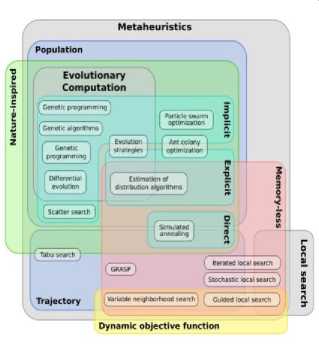
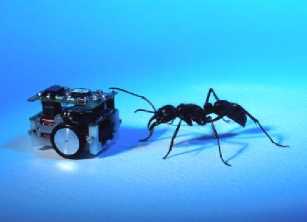
Fig 3. Alice Ant[3]
Fig 1. Relation between different Bio-Inspired Algorithms [2]
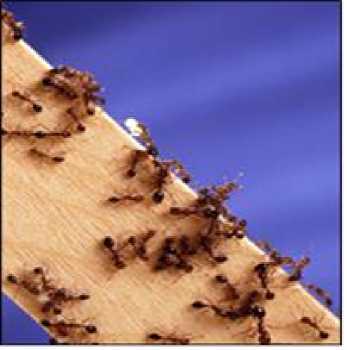
Fig 2. Fire Ant[3]
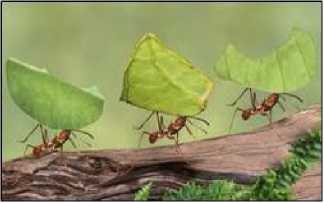
Fig 4. Leafcutter ants [4]
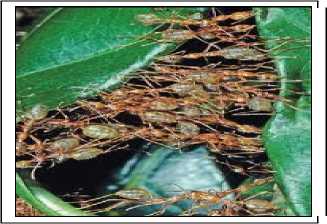
Fig 5.Weaver Ants (oecophylla) [5]
Army ants have two hundreds species. They are an aggressive predatory foraging group. Most of the army amts belong to subfamily of ecitoninae. Ecitoninae has two groups: i) cheliomyrmecini, ii) ecitoninae. Ecitoninae has four genera: i) Neivamyermex, ii) Nomamyermex, iii) Labidus, and iv) Eciton. Eciton, Figure 6, makes a long journey for forage with a group of 20,000 workers. In a social insect colony, a worker participates in a specialized task according to its morphology, age and chance. As a result high efficiency is achieved by the group for the global work. In polymorphic species of ants, different (two or more) physical types of workers work together. For example, in phedole species, minor workers are smaller and distinct from the major workers. Minors and majors perform different parts of the same. Majors cut or bring large prey with their large mandibiles or protect their nest, whereas minors feed the brood or clean their nests. In many species, major workers compensate within a small period of time, if a minor is to be released from a work. This division of labour exhibits a high degree of flexibility. Honey bees (Apis Mellifica) figure 7 develop a series of parallel comb out of wax by forming chains due to which temperature increases locally. Increased temperature gives shape to the wax combs which can be untwisted and be made parallel due to the combined force of individual chains. Each comb is a collection of concentric rings of brood, pollen, and honey. According to the quality and distance from the hive, forage is explored. Potential nesting sites are first carefully selected by scouts, and then the queen bee and half of the workers of the honey bee colony leave the hive for a new hive and cluster on the branch of a tree. The selection of sites takes up several days and regulates its temperature. Wasp: Polybia Occidentalis (wasps) have three categories of workers involved in nest building, i) pulp foragers, ii) water foragers, and iii) builders. The group size is decided by the flow of information among themselves. Tropical wasps (Parachartergus, Epipona) make peculiar nest of complex structure. The nest is made up of a peripheral or central entrance hole with a series of horizontal comb protected by an external envelope.
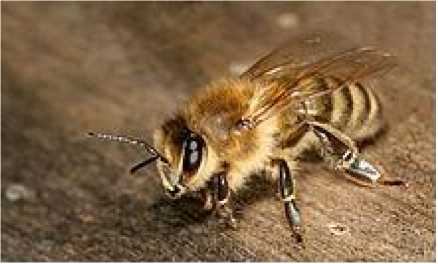
Fig 7. Honey bees (Apis Mellifica) [7]
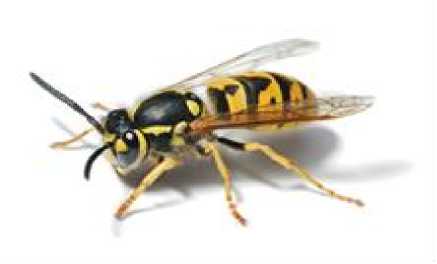
Fig 8. Wasp[8]
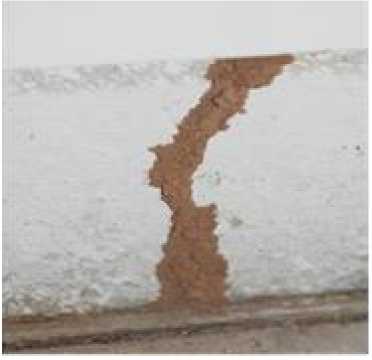
Fig 9. Termite[9]
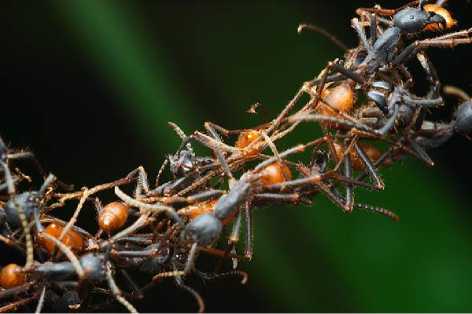
Fig 6. Eciton form bridge between a gap[6]
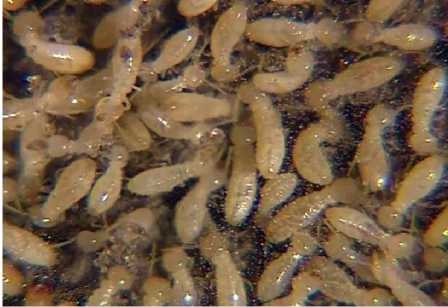
Fig 10. Termite[10]
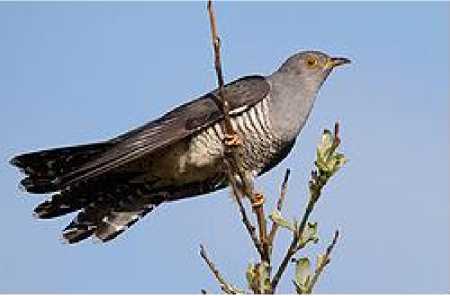
Fig 11. Cuckoo[12]
Termites: Macrotermes, figure 9 and figure 10, construct more complex nests with roughly cone-shaped outer walls with conspicuous ribs with ventilation ducts from the base up to its summit, brood chambers in the central of the nest which consists of the horizontal lamellae supported by pillars, a base plate with spiral cooling vents. A royal chamber is a thick walled protection bunker which is built within a few minute. There is a hole in the walls through which workers can pass. Fungus garden is draped around the hive and special galleries or combs lie between the inner hive and the outer walls for isolation. Pheripheral galleries surround both above and below ground which connect the mound to its foraging sites. One question arises that there should be someone in-charge who explains such sophisticated complex activities for the social insects. These complex insects can process sensory inputs, change their behavior according to the stimuli, and make decision without direct communication between inmates after processing large amount of information. The total complexities of social insects’ colonies are more or more complex than the individual complexity of each insect. Therefore, it leads to a question: how does these cooperation and communication exist?
Cuckoo: The first impressions about cuckoo Figure 10 are their beautiful tone. But apart from their sound, they have spectacular intrusion reproductive strategy. This is known as brood parasitism [11].The flight mechanism is followed by Lévy Flight. A Lévy Flight can be thought of as a random walk where the step size has a levy tailed probability distribution. Cuckoo Search (CS) is a new metaheuristic search algorithm. It is characterized by three laws: each cuckoo lays one egg at a time and dispose the egg at random chosen host nest, secondly the best nest with excellent quality of eggs will carry over to the next generation, and lastly the number of host nest is fixed and the probability of parasitic egg discovery by the host bird is pa € [0,1].Currently swarm, swarming, swarm intelligence, swarm optimization, swarm engineering, and swarm robotics are popular and lots of avenues are opening. In 2002 Wolfram published a new book on cellular automata which was of significant interest 20 years ago [13][14]. Gerardo Beni was inspired by selfreproducing robots of cellular automata where patterns of considerable complexity created out of simple rules [15] and used the term “cellular robot” in a general way.
Fukuda of Japan introduced the term “cellular robots” to indicate groups of robots representing cells of an organism for assembling more complex parts [16]. Alex Meystel was not happy with the word “cellular robot”, but proposed the buzz word “swarm” because the robot group was not just a group. It had very prominent characteristics of swarm groups insects, i.e., decentralized, lack of synchronicity, and identical or quasi identical members, still very simple. These groups are not as big as to take statistical average as well as not so small for few body problem [17].The groups are in the range of 1021023 in size. Observing the behavior of Polistes dominulus wasps, Guy Theraulaz proposed four characteristic profiles, i) sitting at the back of the nest, ii) active general behavior on the comb, iii)foraging for prey, and iv)building activity by means of dynamic clouds classification algorithm. Multivariate methods were incorporated for analyzing the individual behavior among various behavioral items [18].The progress of swarm robots was slow, until biologists and researchers on optimization started to utilize the swarm robotics. As a result the term “Swarm Optimization” coined. As the time elapsed it has been observed that concept of Swarm has some characteristics of intelligence. It leads to “Swarm Intelligence” where pattern recognition and analysis can be carried out for optimizing a function [19]. Swarm Intelligence is more complicated than the predecessors. Ultimately researchers developed thought as: Machine: an entity capable of mechanical behavior, i.e., of transferring and/or processing matter/energy. Automaton: an entity capable of informational behavior, i.e., of transferring and/or processing information. Robot: a mechanical automaton, i.e., an entity capable of both mechanical and informational behavior. Intelligent robot: a robot capable of forming material pat-terns unpredictably .Intelligent swarm: a group of non-intelligent robots (“machines”) capable of universal material computation.
-
II. Cooperation And Self-Organization In Swarm Intelligence
The cooperation mechanism is determined genetically as in polymorphic ants, the divisions of labour are distributed between minor and major ants according to their ability. Whereas collective activities are mostly selforganized. Theories of self-organization (SO) were developed according to natural scientific phenomena to explain macroscopic patterns out of processes and interactions defined at the microscopic level as “complex collective behavior which means the interactions among the simple behavior of individual insects” .It is shown that SO is indeed a major ingredient of a collective phenomenon of these social insects. Flying from nest to source and back is a complex sensorimotor mechanism but collective behavior of food selection in honey bees in a model need not require detail implementation of flight back and forth, rather consider a simple behavior. Although from the point of view of neurobiological description level, it is a major task. Similarly, for aerodynamics of airplanes models, elementary particles model are not required. Model based on SO are logically sound and robust assuming that models are complex with simple interacting elements. The study of SO in social insects helps human civilization to provide a powerful tool for intelligent design where a system can be compared with colony having different sub-systems like simple elements to coordinate. Therefore social insect colony is nothing but decentralized problem solving system with simple interacting entities. The daily problem solved by a colony are as follows: finding food, building or extending nest, efficiently dividing labor among individuals, efficiently feeding the brood, responding to external challenges, spreading alarms, etc. Social insects solve these problems efficiently in a flexible and robust way. These features are adapted to engineering, sciences and computer technology to solve several critical problems in recent years in the following manner. Flexibility explores adaptation to changing environment. Robustness drags the swarm colony towards the goal even though an individual may fail to perform the tasks. Limited cognitive abilities help each individual to mimic the surrounding behavior just as in the case of as in robotic agents. With all these parameter of a SO complex colony leads to design of artificial decentralized problem solving devices. Very few applications have been developed as because it is very hard to design for emergent SI based System program to define local as well as global behavior. There are two possible ways to develop artificial model using social insects’ behavior. One way is to register all behaviors of social insects, but such a task is boring and endless. Another way is to model the behavior of social insects to do some specific tasks. These models are used upon artificial systems directly or changing some parameters i.e., biological or non-biological features.
-
A. Animal Swarm Governed by Three Simple
Mathematical rules
-
i) Move in the same direction as your neighbors, ii) Remain close to your neighbors, iii) Avoid collision with your neighbors.
-
B. Emergence
One of the characteristics of swarm intelligent systems are emergence .It represents self-organization. This can be explained very clearly by the behavior of ants. Ants perform complex tasks without any direction and coordination between themselves; still they complete the tasks efficiently. Stigmergy is the indirect coordination between agents .For example, in ants it is the indirect coordination for forage .These ants are very small, almost blind, memoryless, still they form groups and efficiently collect forage from a distant place.
-
C. Collective Behavior modeling in social insects
-
i) Significance of Modeling and Designing a System
The aim of a system is to design an adaptive, decentralized, flexible and robust artificial system capable of problem solving, inspired by social insects. To understand the collective behavior of social insects it is important to develop a model. Modeling is different from an actual artificial system. In modeling, an actual natural system is replicated by parameters mechanism and structures must have some biological plausibility. Moreover, the model should make testable predictions and all variables and parameters should be accountable for the experiments ideally. A system designer should only be concerned with efficiency, flexibility, robustness and cost of the system not with biological feasibility. Natural selection (evolution) picks up the most efficient, flexible, or robust biological organization. Engineers/researchers use new metaphors using remarkable success of social insects who survive for several million of years. Artificial Neural Network (ANN) has been developed using the same approach as of our brain and in case of evolutionary algorithm, evolution serving as starting metaphors.
-
ii) Self-organization in social insects
SO is a set of dynamic mechanisms. Interaction between subsystems at the local level unitedly transforms the final structures at the global level of a subsystem. The rule that guides the interaction between subsystems at the local level, purely on local information without any global goal pattern. This is an emergent property of the system and not any external ordering influence. The spatiotemporally organized networks of pheromone trails are an emergent structure in the case of ant’s foraging. SO follows four basic ingredients: i) Positive feedback: It is the basis of morphogenesis. This is the “rules of thumb” to promote the creation of structures. It includes recruitment and reinforcement. Recruitment to a food source relies on trail path by other ants. In case of bee colony: A bee finds a nectar source, goes back to her hive and gives up her nectar to a hive bee. Then she starts dancing to indicate other bees the direction of forage or she can discard her forage source and became uninterested follower. The bees exploit two sources symmetrically if there are two nectars at an equal distance from the hive. If one source is better than the other, then bees suck the better source even if it is discovered later. It is experimentally proved that a bee has a relatively high probability of dancing for good forage to abandon a poor food source. This simple behavioral rule allows bees to select a good quality source. ii) Negative feedback: It helps to stabilize the collective pattern. It is in the form of saturation, exhaustion, or competition. Negative feedback is the indication of limitation of forage, satisfaction, food exhaustion, crowding at the food source, or competition between food sources. iii) Amplification of Fluctuation: In some instances, foragers may lose in the way by following the pheromone trails with some level or degree of error. Lost foragers can find new, unexploited food sources and recruit nest mates to the new sources. It is a guide line for the SO on amplification of fluctuations (random walks, errors, random tasks [switching], and so on). Due to these fluctuations new solutions or structures emerge for the betterment of the systems. iv) Multiple Interactions: SO depends on multiple interactions with individuals. In case of ants pheromone trail laid by earlier workers is followed by follower ants and followers lay pheromone trails on the path traced earlier provided the life-time of the pheromone trail is sufficient. All these require minimum degree of tolerance of individuals. Therefore, individual signature or memory is used collectively achieving a global goal.
-
D. Self-organized pheromone is characterized by a few key properties
-
i) . The creation of spatiotemporal structures in an initially homogeneous medium. Examples of such structures are: nest architectures, foraging trails, or social organization. Honey bee colony is the example and its hive architecture i.e., comb of wax in well-organized patterns. Cellular automation is based on this assumption.
-
ii) . There is possibility of co-existence of several stable states (Multi-stability). Suppose there are two food sources. Honey bee colony will be attracted to one of them and exploit it massively while neglecting the other .This selection depends on random initial events. iii). The existence of bifurcations when some parameters are varied. The behavior of a SO system (SOS) changes dramatically at bifurcations. Example: Macrotermes termites usually build two phases of pillars of soil pellets. First one is non-coordinated phase characterized by random deposition of pellets until a critical size is reached. Then coordinated phase starts with large group of sufficient size. Pillars or strips emerge. Positive feedback mechanism enhances the pace of work by dragging more materials by attracting the workers through diffusion of pheromone emitted by pellets. This autocatalytic “snow ball effect” leads to the coordinated phase. If the number of workers is too small then pheromone evaporates quickly and amplification mechanism cannot work. Only non-coordinated phase is observed.
-
III. Stigmergy
Self-organized social insects need communication among themselves. Communications may be direct or indirect. Direct interactions are the “obvious” interaction like: antennation, trophallaxis (food or liquid exchange), mandibular contact, visual contact, chemical contact (the odor of nearby nest mates), etc. Indirect interaction is more subtle: two individuals interact indirectly with one modifying the environment while the other responds to the environment at a later time. This is a classical example of stigmergy. Grasse introduced stigmergy (stigma: sting and ergon: work which is Greek word) to narrate work coordination and regulation of nest construction in Macrotermes termites. Grasse experimented and observed the development of building activities among workers by the stimulating nest structure. A stimulating configuration triggers the response of a termite worker from one configuration to another better configuration which may transform many more with the same group or from another group of other colony. At first building strips and pillars are erected with soil pellets and stercoral mortar, then arches are thrown between pillars and finally space in-between pillars are filled with soil pellets to make walls. Individual behavior regulates environments which in term modifies or controls the behavior of other agents i.e., colony. In case of termites, stigmergy motivates termites to build construction by means of SO. In case of ants, stigmergy and SO are combined for modifying environment to follow pheromone trails for the nest mates. Even if it is also observed that some inmates reduces its cleaning activity so that they can engage for forage i.e. stgmergy. It is also observed that wasp-like ants’ agents build hive when they find brick of specific size. Depositing bricks of certain size enhances environment and by stigmergy and stimulation, other agents also start collecting same size bricks using positive feedback. From the above discussion, it is clear that stigmergy motivates a system to work. This is essence of designing groups of artificial agents to solve a problem. Indirect communication is preferred to direct communication. Incremental improvement is widely used in optimization: a new solution is developed from the previous solution and this can be compared to building a new nest of termites using an older one. A colony can respond collectively to a distributed with each agents following same behavior. In case of artificial agents, this type of flexibility is priceless as agents can respond to an agitation without previous knowledge or reprogramming.
-
A. Modeling Systems understanding Nature
Useful systems are invented by understanding nature. Understanding nature requires deep observations and carrying out experiments to validate the observations... Designing a system requires knowledge of observations, executing experiments and implementing the obtained result by available technology. The first step of designing is modeling. Artificial Systems are inspired by Models of natural social insects behavior and colonization work. Models are small replica of original systems. All the observed attributes of the natural systems are imposed as well as hidden attributes tried to be imbibed in the model with some manipulation of original system parameters for better efficiencies and adaptation in the new environments. A good model has several qualities: parsimony, coherence, refutability etc. It is in our knowledge that social insects have the ability to solve problems successfully. It is our endeavor to create an abstract of the whole phenomenon and formulate it in algorithmic language to solve a problem. Example: optimization algorithms extract foraging behavior of social insect colonies with some manipulation in pheromone evaporation factor for biological plausibility.
-
B. From Algorithms to Robotics
Swarm-based robotics is growing by leaps and bound. “Autonomous Robots” journal dedicated issues to “colonies of robots”. Other journals also publishing special issues on robots colonies. The design of distributed control mechanisms robots are the example of swarm-based robotics. Swarm-based robotics is distributed, robust, decentralized and self-organized. Sometimes a single robot is unable to perform a complete task alone due to its complexity and time consumption. Then swarm robotics is the only solution. But coordination and co-operation is needed between them, which is not a necessary criterion. Increased speed is the result of using several robots. The underlying mechanism allows robots to work together with a minimum interference principle. A simple small robot is easy to design with simple sensorimeter apparatus. They are cheap, more reliable, and fault tolerant. Using such several robots to perform a complex task with high speed can be achieved without the need to reprogram. One or more than one robots may fail but it would not affect the completion of task, although completion time may be affected by such a disturbance. Theories of SO predict that collective behavior may generate patterns which are qualitatively different from that of a single agent or robot .Randomness in behavior in each agent explore new behavior far from being harmful ,enhancing a system’s ability to generate new solutions. Robot to robot communication with increased number of robots become a great challenge when decentralization with SO and indirect communication giving a solution. Stagnation i.e. lack of global knowledge is a serious issue. Due to this a group of robots may find themselves in a deadlock. Emergent behavior sometime may become a great problem as preprogramming is not possible. There is no guide line for heterogeneous robots. Connectionism, sensorimeter, intelligence are new paradigms in the field of classical AI programming like reasoning and high level components cognition. Swarm Robotics considers that a group of robots can perform a task without explicit representation of the environment and what of the other robots, and planning is replaced by reactivity. With the advent of Integrated Technology and other hardware support, modeling and designing robot become cheaper and easier. The concept of Artificial Life developed from the emergent behavior of social insects gave the world of robotics a revolutionary change that leads to globalization of internet based information society. Swarm robotics has been improved by positive feedback. The field is booming, but very few original works are observed. Deveza et. al., [20] introduced Oder sensing robot guidance. Rusall [21] proposed short-lived heat trail. Prescoll and Ibbotson[22] developed original medium of communication to produce the motion of prehistoric worms, bathroom tissue etc.
-
IV. Application And Potential Areas Of Swarm Robotics
-
A. Aerospace technology
A team of flying robot swarm may repair satellite or aircraft.2. Environmental swarm robots can maintain pipe inspection and pest eradication.3. Industrial robots could perform waste disposal and micro cleaning.4. Ship maintenance, ocean cleaning can be done by swarm robots.5. Microsurgical robots can operate on complex minute body injuries [23].
-
B. Swarm Robotics in Telecommunication Networks
Distributed time varying problems solving based on swarm optimization are the vast unexplored field for researchers. Routing in telecommunications is dynamic as well as distributed. Routing is a mechanism by which information in a network is transferred from one source to another destination through a sequence of intermediate switching /buffering stations or nodes. In real networks all nodes are not directly connected Otherwise cost of the network will be unlimited. Only a few nodes are directly connected. Routing selects the path for the information to be traversed from source to destination by optimizing the objectives and constraints. Therefore, the objective of any routing algorithm is to direct the traffic from the source to destination with maximizing network performance. And minimizing costs (i.e., rate of call rejection, throughput, packet delay, etc). Routing algorithms differ due to characteristics of the network and of the traffic. Traffic conditions are changing constantly and network architecture / structure may fluctuate resulting in node/link failure. There are more than one path /route for one message from source to destination node. Routing algorithms should be adaptive to overcome local congestion, i.e., if congestion occurs in one link packets should be transferred to another less congested link. Handling sudden burst of activity in nodes, whether it is a receiver or transmitter, the way calls are routed becomes crucial. Static routing is therefore never implemented in a practical case. Wide spectrum of dynamic routing systems exists which changes the speed of response. There are some quasi static routing systems where the system modifies only on some exceptional events (link or switch failure) and/or on a long time scale. Other routing systems are highly dynamic and autonomously update traffic routing in real time according to user and network current status. Dynamic routing requires more real time data and computational resources than static and quasi static routing. It depends on the information of active participation of entities within the network to measure traffic, network state and performance and to compute routes. Examples of swarm routing are: ABC routing for telephone network, ANTNET routing in data communication network, and ANT routing based on Ant System.
-
C. Swarm Intelligence in Civil Engineering Design Multi-Objective
Civil engineering problem solution is being used by SI for better performance in real world engineering design [24]. Elitist-mutation, an efficient mutation strategy, is being incorporated in the algorithm which effectively explores the feasible search space, thus speeding up the search for the true Pareto-optimal region. The proposed method is evaluated and certified over numerous benchmark problems comparing with NSGA-II, one of the best multi-objective evolutionary algorithms available at present. Three practical engineering design problems have been applied yielding efficient results with wide spread solutions providing good coverage and convergence to true Pareto-optimal fronts.
-
D. Swarm Intelligence in Image processing
The swarm intelligence technique has been applied in image processing for feature extraction [25]. The correlation between adjacent image points for image feature extraction has been proposed using the perceptual graph. The perceptual graph has been built by the ant colony system of SI. The perceptual graph is the basis of the layered model of a machine vision system. Digital image edge feature and image segmentation have been examined using what proposal machine vision model. It has been validated that the artificial ant swarm can perform feature extraction in digital images efficiently. Swarm Intelligence is highly popular in entertainments business. Billions of dollars are spending.
-
E. Swarm Intelligence in Entertainment
Science fiction writer Olaf Stapledon was the first who had narrated swarm intelligences equal or superior to humanity. Penumbra: Black Plague (2008), a video game where the Tuurngait is a hive mind that grows by infecting other organisms with a virus [26].
-
F. Swarm Intelligence in Control Engineering
Principally non-linear controlled system design demands sensitivity and robustness. The error between the controlled output and the set-point, one of the performance objectives, should be as small as possible. Comparative study on performance metrices has been carried out between Evolutionary Algorithms namely GAs (Genetic Algorithms), and Swarm Intelligence i.e. PSO (Particle Swarm Optimization) and BG (Bacterial Foraging). Performance indices are ITAE (Integral Time Absolute Error), ISE (Integral Square Error), IAE (Integral Absolute Error) and MSE (Mean Square Error) and settling time. Most commonly used, the highly nonlinear Inverted Pendulum system is used as a test system for model generation and optimization of PD-PI controller .The simulation results with PSO techniques validate to be more efficient than with GAs and BG [27].
-
V. Conclusion And Future Scope
After discussing on all these issues regarding swarm intelligence, authors come to a conclusion that social insects are natural systems and their systematic social mechanism can enlighten the design of algorithms and AI problem solving systems. Flexible, decentralized, selforganized, and robust natural social insects are successful in a biosphere. Artificial systems are designed to exhibit these features. Therefore swarm intelligence systems seem to be efficient and adaptive in the modern society where complexity, dynamicity and overload of information are the specification of any system as well as the algorithms in them. The lack of absolute reliability of a system becomes a burning problem to design a system as some parameters of the system are unpredictable. The standard benchmark is not available for evaluation. Lot of exploration with a given system has to be carried out before final use of the system and this is time consuming as well as costly.SI is all about complex information processing by a simple system/computer in the form of a program with few lines of codes through mathematics. Human intelligence observing the social insects transforms metaphor for the program; socio-cognitive aspects supporting the simulations. There is a mysterious relationship between simulation and metaphor. Two interesting thing exists simultaneously: things exist in the real world and thing exists mentally or in the mind. This mental thing is intelligence. There is also some difficulty to distinguish attribute and quality of these social insects. Integration of individual experience is social learning. . “Life”, “intelligence”, and “mind” are very often used in “swarm intelligence”. Though the term “swarm” is used for the social insect behavior representation, here authors tried to point to cognitive behavior of any living colony. Swarm colony like behavior, on an average, is practiced in any living social colony. Socio-psychological simulation program is now being used successfully in commercial field. Power grid in Asia, high-tech product development in USA, and solving high dimensional, nonlinear, noisy mathematical problems. Researchers all over the world are working on Particle swarm optimization. This approach is extremely versatile and robust. It should be said here that swarm intelligence is in its childhood. Lots of avenues are unfolding before us with metaheuristic hybridization. Seminars, conferences, workshops, and text materials on this subject awareness and harness the pace leading to new ideas.
Список литературы Nature-Inspired Swarm Intelligence and Its Applications
- G. Beni and J. Wang, Swarm intelligence in cellular robotic systems. In NATO Advanced Workshop on Robots and Biological Systems, Il Ciocco, Tuscany, Italy, 1989.
- http://en.wikipedia.org/wiki/Metaheuristic
- www.themedicieffect.typepad.com
- www.blog.livingroutes.org
- www.sciencemag.org
- www.myrmecos.net
- http://en.wikipedia.org/wiki/Carniolan_honey_bee
- www.lga.sa.gov.au
- www.termites.com
- www.orkin.com
- S. Roy, S. S. Chaudhuri, Cuckoo Search Algorithm using Lévy Flight: A Review, DOI:10.5815/ijmecs.2013.12.02,Vol-5,No-12.
- http://en.wikipedia.org/wiki/File:Cuculus_canorus_vogelartinfo_chris_romeiks_CHR0791_cropped.jpg
- Wolfram, S. (1984). "Computation theory of cellular automata". Communications in Mathematical Physics 96: 15–57. DOI:10.1007/BF01217347
- Wolfram, S. "A New Kind of Science", Wolfram Media (2002)
- Swarm Intelligence from natural to Artificial System by Eric Bonabeau and Marco Dorigo
- Fukuda, T., Nakagawa, S. "Approach to the Dynamically Reconfigurable Robotic System", Journal of Intelligent Robotic Systems, 1, (1988) 55–72
- Erich Schmid, Horst Ziegelmann, The quantum mechanical three-body problem, University of California, 1974
- Theraulaz, G., Pratte, M., Gervet, J., "Behavioural profiles in Polistes dominulus Christ wasp societies: a quantitative study", Behaviour, 113 (1990) 223–250
- E. Bonabeau, M. Dorigo, and G. Theraulaz, Swarm Intelligence: From Natural to Artificial Systems, Oxford University Press, Oxford, 1999.
- Deveza, R., D. Thiel, A. Russell, and A. Mackay-Sim. "Odor Sensing for Robot Guidance." Int. J. Robotics Res. 13 (1994): 232-239.
- Russell, R. A. "Mobile Robot Guidance Using a Short-Liived Heat Trail." Robotica 11 (1993): 427-431.
- Prescott, T. J., and C. Ibbotson. "A Robot Trace Maker: Modeling the Fossil Evidence of Early Investebrate Behavior." Artificial Life 3(4) (1997): 289- 306.
- Kube, C. R. "Collective Robotics: From Local Perception to Global Action." Ph.D. Thesis, University of Alberta, 1997.
- M. Janga Reddy and D. Nagesh Kumar, An efficient multi-objective optimization algorithm based on swarm intelligence for engineering design, Engineering Optimization , Vol. 39, No. 1, January 2007, 49–68.
- X. D. ZHUANG1 and N. E. MASTORAKIS, Image Processing with the Artificial Swarm Intelligence, Advances in Image Analysis - Nature Inspired Methodology, ISBN: 978-960-474-290-5, Published by WSEAS Press.
- http://en.wikipedia.org/wiki/Swarm_intelligence
- Optimization of PD-PI Controller using Swarm Intelligence, Tushar jain, M. J. Nigam, Journal of Theoretical and Applied Information Technology.
- J. Kennedy and R. C. Eberhart. Particle Swarm Optimization. In Proceedings of IEEE International Conference on Neural Networks, Perth, Australia, pp. 1942–1948, 1995.
- R. C. Eberhart and J. Kennedy. A new optimizer using particle swarm theory. In Proceedings of the Sixth International Symposium on Micro Machine and Human Science, Nagoya, Japan, pp. 39–43, 1995.
- D. Karaboga, An Idea Based On Honey Bee Swarm for Numerical Optimization, Technical Report-TR06,Erciyes University, Engineering Faculty, Computer Engineering Department, 2005.
- D. Karaboga and B. Basturk, A Powerful And Efficient Algorithm For Numerical Function Optimization: Artificial Bee Colony (ABC) Algorithm, Journal of Global Optimization, Springer Netherlands, Vol. 39, No. 3, pp: 459-471, 2007.
- A. P. Engelbrecht (ed.), Computational Intelligence: An Introduction. John Wiley & Sons, England, 2002.
- C. P. Lim, L. C. Jain, and S. Dehuri, Innovations in Swarm Intelligence: Studies in Computational Intelligence, Vol. 248, Springer, 2009.
- S. Das, B. K. Panigrahi, and S. S. Pattnaik, Nature-Inspired Algorithms for Multi-objective Optimization, Handbook of Research on Machine Learning Applications and Trends: Algorithms Methods and Techniques, Hershey, New York, Vol. 1, pp. 95–108, 2009.
- S. Das, A. Abraham, and A. Konar, Swarm Intelligence Algorithms in Bioinformatics, Studies in Computational Intelligence. Vol. 94, pp. 113–147, 2008.
- K. E. Parsopoulos and M N. Vrahatis, Particle Swarm Optimization and Intelligence: Advances and Applications, Information Science Reference, Hershey, Pennsylvania, 2010.
- E. Bonabeau, C. Meyer, Swarm Intelligence: A Whole New Way to Think About Business, Harvard Business Review, Vol.79, No.5, pp. 106-114, 2001.
- K. M. Passino, Biomimicry of Bacteria Foraging for Distributed Optimization and Control, IEEE Control Systems Magazine, Vol. 22, 52–67, 2002.
- S.-C. Chu, P.-W. Tsai and J.-S. Pan, Cat swarm optimization, Proc. of the 9th Pacific Rim International Conference on Artificial Intelligence, LNAI 4099, pp. 854-858, 2006.
- M. Bakhouya and J. Gaber, An Immune Inspired-based Optimization Algorithm: Application to the Traveling Salesman Problem, Advanced Modeling and Optimization, Vol. 9, No. 1, pp. 105-116, 2007.
- K.N. Krishnanand and D. Ghose, Glowworm swarm optimization for searching higher dimensional spaces. In: C. P. Lim, L. C. Jain, and S. Dehuri (eds.) Innovations in Swarm Intelligence. Springer, Heidelberg, 2009.
- L. Keller and E. Gordon, The Lives of Ants, Oxford University Press, Oxford 2009.
- D. E. Jackson, F. L. Ratnieks, Communication in ants, Current Biology, Vol. 16, No. 15, pp. R570–R574, 2006.
- P. Karlson and M. Lüscher, Pheromones: a new term for a class of biologically active substances. Nature, Vol. 183, pp. 55–56, 1959.
- C. Lloyd, The alarm pheromones of social insects: A review, Technical report, Colorado State University, 2003.
- S. Goss, S. Aron, J.-L. Deneubourg, and J. M. Pasteels, Self-Organized Shortcuts in the Argentine Ant, Naturwissenchaften, Vol. 76, pp. 579-581, 1989.
- M. Dorigo and T. Stützle, Ant Colony Optimization. MIT Press, Cambridge, 2004. ISBN: 978-0-262-04219-2.
- N. Zhao, Z. Wu, Y. Zhao, and T. Quan, Ant colony optimization algorithm with mutation mechanism and its applications. Expert Systems with Applications, Vol. 37, No. 7, pp. 4805-4810, 2010.
- R. Beckers, J.-L. Deneubourg, and S. Goss, Modulation of trail laying in the ant Lasius niger (hymenoptera: Formicidae) and its role in the collective selection of a food source, Journal of Insect Behavior, Vol. 6, No. 6, pp. 751–759, 1993.
- L. M. Gambardella, M. Dorigo, Ant colony system hybridized with a new local search for the sequential ordering problem. INFORMS J. Comput, Vol. 12, No. 3, pp. 237–255, 2000.
- C. Blum, Beam-ACO—Hybridizing ant colony optimization with beam search: An application to open shop scheduling, Comput. Oper. Res., Vol. 32, No. 6, pp. 1565–1591, 2005.
- Sangita Roy, Sheli Sinha Chaudhuri, Bio-inspired Ant Algorithms: A review, IJMECS, DOI: 10.5815/ijmecs.2013.12.02 ,ISSN: 2075-0161 (Print), ISSN: 2075-017X (Online).
- Sangita Roy, Sheli Sinha Chaudhuri, Cuckoo Search Algorithm using Lévy Flight: A Review, 2013, 12, 10-15, DOI: 10.5815/ijmecs.2013.12.02,Vol-5,No-12ISSN: 2075-0161 (Print), ISSN: 2075-017X (Online).
- Swarm Intelligence by James Kennedy and Russell Eberhart.
- B. K. Panigrahi, Y. Shi, and M.-H. Lim (eds.): Handbook of Swarm Intelligence. Series: Adaptation, Learning, and Optimization, Vol 7, Springer-Verlag Berlin Heidelberg, 2011. ISBN 978-3-642-17389-9.
- C. Blum and D. Merkle (eds.). Swarm Intelligence – Introduction and Applications. Natural Computing. Springer, Berlin, 2008.
- M. Belal, J. Gaber, H. El-Sayed, and A. Almojel, Swarm Intelligence, In Handbook of Bioinspired Algorithms and Applications. Series: CRC Computer & Information Science. Vol. 7. Chapman & Hall Eds, 2006. ISBN 1-58488-477-5.
- M. Dorigo, E. Bonabeau, and G. Theraulaz, Ant algorithms and stigmergy, Future Gener. Comput. Syst., Vol. 16, No. 8, pp. 851–871, 2000.
- M. Dorigo, V. Maniezzo, and A. Colorni, Positive feedback as a search strategy, Tech. Report 91-016, Dipartimento di Elettronica, Politecnico di Milano, Italy, 1991.
- M. Dorigo, Optimization, learning and natural algorithms (in Italian), Ph.D. Thesis, Dipartimento diElettronica, Politecnico di Milano, Italy, 1992.
- A. Colorni, M. Dorigo, V. Maniezzo, and M. Trubian. Ant System for Job-shop Scheduling. Belgian Journal of Operations Research, Statistics and Computer Sci-ence, 34(1):39-53, 1994.

